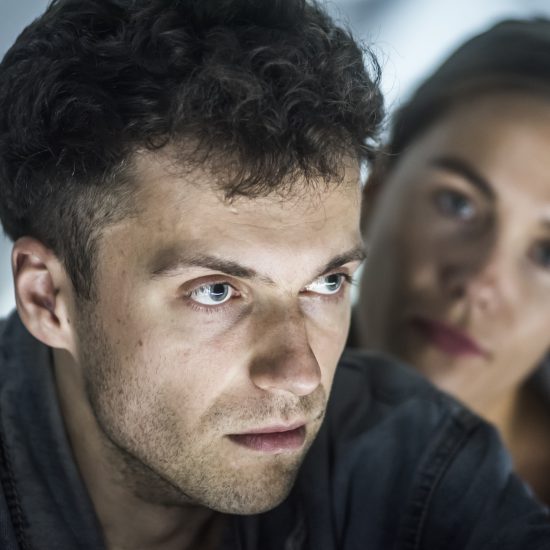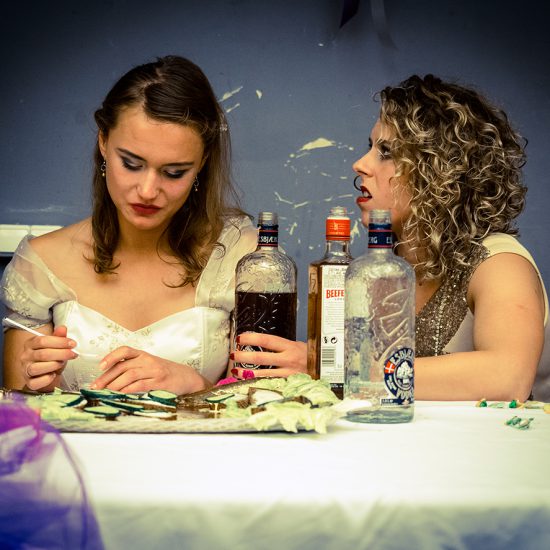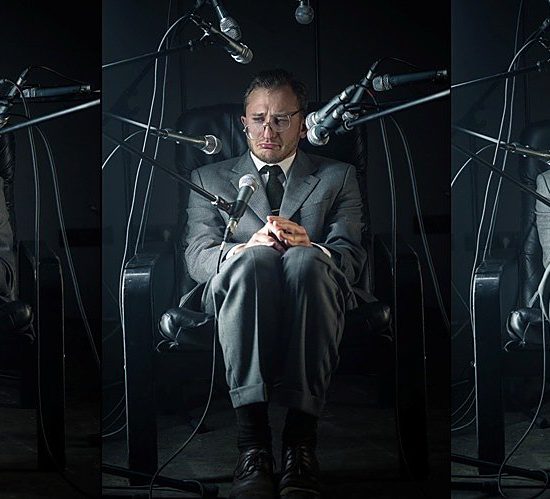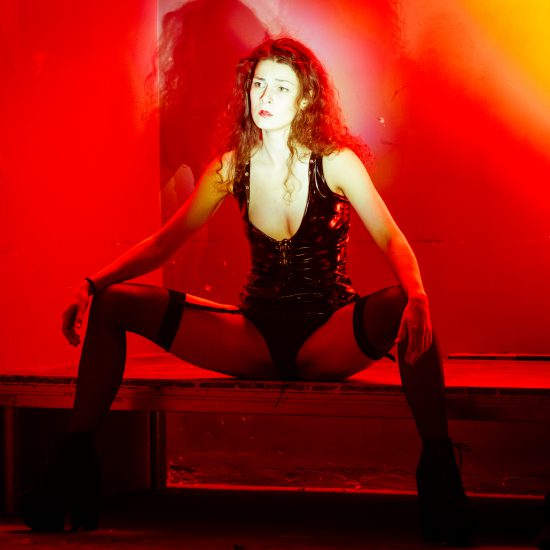The Seagull directed by Oskaras Korsunovas
This account concerns the third performance of The Seagull directed by Oskaras Korsunovas with the OKT/Vilnius City Theatre as part of the 2013 Sirenos Festival held annually in Vilnius. The fact that, to date, Korsunovas has not announced the production’s official premiere may well suggest that he feels it is not altogether ready — and this, irrespective of its laboratory-like quality, which is fully intentional and absolutely integral to the production’s structure and aesthetic.
Korsunovas’s laboratory perspective is evident from the very beginning. The actors sit against one wall of the company’s relatively narrow performance area as the spectators come in, and it is from here that they take up their roles in the central, open space before they return calmly to their seats on the side. On occasion, they respond facially to something said by one character about their character, or about a character with whom they will soon interact, as any actor might in rehearsal. Such is the case, for instance, when Nele Savicenko, who plays Irina Arkadina, wryly smiles and nods her head during Treplev’s remark (Martynas Nedzinskas) that his mother is an oddity. It is from this area, too, that Nedzinskas firmly establishes the production’s two-track principle, by which actor and character are differentiated. First, he speaks directly to the spectators, asking them to turn off their mobile phones (actor). At the same time, now up on his feet and moving forward, he talks to them as if they were the audience of Treplev’s play (character). Here, as elsewhere, the transition from actor to character is seamless.
No sooner has Treplev finished his speech than the remaining actors move away from the wall to the chairs waiting for them in the central space. The sole exception is Dainius Gavenonis, who plays Dorn and who sits against the wall opposite theirs. Gavenonis merges more or less with the spectators until he appears later as Dorn among the other characters in a rather strange rendition of Dorn as a practitioner of yoga. The image is unexpected, conforming to Korsunovas’s interest in surrealistic juxtapositions. Nevertheless, the image of Dorn-as-yogi is awkward rather than surrealistically arresting in the subtly equilibrated composition. Even the humour of Dorn’s yoga positions, their contours exaggerated by the silly pile-up of his hair, is not on the right note. It is only in Act IV, after Dorn’s journey abroad, during which the crowds of Genoa had so enthralled him, that the earlier suggestion concerning his apartness from his group (yoga, it seems, is a marker of difference) has the requisite resonance. Thus only at the end, as he enquires after Nina, does his difference of appearance — this time in a suit, with his hair slicked back — make its point convincingly.
From start to finish, the actors fade in and out of their characters to indicate that they are, and are not, whom they perform. All this is not so much low key as done in the most simple and the most natural way possible, as if, indeed, the actors were in rehearsal. Yet this rehearsal is not any rehearsal but one where the actors are so at ease with each other that their playing has erased all efforts to impress. This is a rehearsal of the highest order, shorn of actorly tricks and displays of technique, even though the actors embed their very real technique deeply in the their playing and embody it lightly enough to deliver playing that does not look like ‘playing’ at all. Such is the paradox on which Stanislavsky’s research on natural acting turned. And, apart from the actors’ remarkable abilities, such is the great achievement, here, of Korsunovas’s directing as he guides them along this difficult, transcendent path. This is the same Korsunovas who, with suitable brio, staged in the 1990s the Russian surrealists Daniil Kharms and Aleksandre Vvedensky and who, from Master and Margarita (2000) to Hamlet (2008), explored highly theatricalised idioms. While doing so, he also generated the delirious visions that theatricality helps to release from the dark underside of the human psyche.
Korsunovas’s taste for darkness goes comfortably with the natural performances of the actors and most notably for Treplev’s show, which begins from behind the actors at centre stage, in rows, exactly as in a theatre. However, they face the spectators rather than the back, thus misleading them into thinking that the action will start from the audience. This deception–consistent with the actor-character fade in and out of the whole production–allows Nedzinskas to continue addressing the spectators while Treplev demands the attention of his companions. Savicenko eloquently shows through her gestures for Chekhov’s dialogue the appalling depths of Arkadina’s narcissism, as of her supply of stock-in-trade — the very same that Treplev’s ‘new forms’ intended to eradicate, as did Chekhov’s, as did Stanislavsky’s, and, it would appear, as does Korsunova’s search for the ‘new.’
Korsunovas could not be anything but aware of the pivotal moment of theatre history represented by The Seagull. Not only did it bring together Chekhov, Stanislavsky, the Moscow Art Theatre and Meyerhold, who played Treplev first, but their energy on the ‘new’ was concentrated, and it had a ripple-wave effect of considerable consequence, not only in Russia. It may well be that, more than one hundred years later, Korsunovas’s The Seagull reflects upon the ‘new ‘ then brought into effect and what the ‘new’ might mean for the theatre today.
Be this as it may, the deception exploited by Nedzinskas excites interest in the play-within-the-play initiated by Nina (Gelmine Glemzaite)). She slides out from a space hidden by a black curtain, slides along the back wall and then up a table, stretching further upwards, at the corner of the room. Her body blends into the lighting of an installation, which conjures up the ebb and flow of the sea, or the corrugation of desert sand disturbed by the wind. A score of indeterminate, powerful sounds syncopates her stylized speech, which, for all its rounded enunciation and regulated breathing, does not strike the ear as being opposed to the natural speech of the production.
The play-within-the-play proceeds smoothly enough–regardless of hints of anxiety that filter through the vocal and visual stream — until paper is suddenly set alight at Arkadina’s feet, its fire disrupting the steady glow of candles placed there earlier by Treplev. Treplev’s play is like a ritual, with a sacrificial offering of fire to his mother. Arkadina bursts out with her accusation of ‘decadence’ against her son, backed by more abuse with which she squashes his fragile ego. He, meanwhile, strikes back as he can.
The cruelty of this scene is painfully evident — rare in productions of The Seagull, which, by and large, smooth it over with comedy. Furthermore, it encapsulates the relationship between mother and son, which Korsunovas mercilessly exposes throughout. Never is it more brutally confronted than in Act III, when Arkadina bandages Treplev’s wound. Savicenko begins with sensuous tenderness by caressing Treplev’s naked shoulders and chest. She thereby highlights Arkadina’s sensuality from which can be deduced, as well, the basis of her relationship with Trigorin. But violence between mother and son erupts almost immediately and escalates as each, without voicing the underlying reason, hits out at the other for the mortifying pain caused by Trigorin’s and Nina’s betrayal of them.
The psychological hitting turns into fierce blows as Arkadina beats up her son. The horror of it speaks against this suddenly visibly dysfunctional mother, and several questions cannot, henceforth, be avoided. How can a mother place a fundamentally weak, ultimately double-dealing lover above her son in her affections? Korsunovas does not allow spectators to miss Trepleve’s lines in Act IV about Trigorin’s infidelities, cheating on his mother and Nina simultaneously. Further: How can a selfish mother, even as selfish as Arkadina be so selfish as to ridicule her son’s artistic aspirations, on the one hand, and seriously underestimate his love for Nina, on the other — something she had failed to gauge in Act I and still failed to gauge after his attempted suicide somewhere, off the page and off the stage, between Act II and Act III? Again, Korsunovas does not let dialogue about her stinginess slip by unnoticed, any more than he dissolves it into supposedly ‘Chekhovian’ light-hearted banter. Korsunovas’s grip on Arkadina, like that of Savicenko’s, is secure, while he gives her some room for a little remorse and plenty of it for charm. Even so, there is not enough of it to hide her entrenched self-absorption. Towards the end of Act IV, Savicenko’s steely gaze makes it crystal clear that Arkadina is outright ruthless.
The production wisely does not provide answers to these questions, but the fact that it prompts them indicates their importance for Korsunovas. Furthermore, they recall his production of Hamlet where the mother-son relationship is vital and is woven, as well, into the issue of Hamlet’s madness, which, for Korsunovas, is real rather than simulated or imaginary. Not for nothing, then, does he acutely hear Chekhov’s references to Hamlet in The Seagull. Nor is it for nothing that Hamlet’s speech to his mother about her lack of accurate perception is like a leitmotif underpinning The Seagull. Or at least it can be taken to be so, given how unprepossessing, how totally downright feckless, Trigorin is. You really believe Darius Gumauskas when, speaking as Trigorin, he says he has no will of his own or ever had any. And the actor is perfectly straightforward in his character’s declaration — so much so that any woman listening to him, other than an Arkadina, might laugh out aloud at the pusillanimity of it, or turn away in disgust.
Gumauskas’s performance walks successfully on this tightrope of abjection, leaving spectators free to observe it as he refrains from either parodying his character or giving him up for lost. There are touches of sly satire in his image. Gumauskas, bearded and in dark glasses, and a little pudgy in the face and around his waistline, irresistibly recalls Grotowski; and the similarity in physical appearance is reinforced by the way Gumauskas sits with his knees crossed, moves his hands, and stares, behind the glasses, straight ahead of him. Exactly what the joke is about is between Korsunovas and his actors. But, where Trigorin is concerned, the reference is probably to the guru status Nina invests in him. It probably alludes, as well, to Arkadina’s view of him as a writer of significance: this also feeds her narcissism.
Then, however, there are Trigorin’s deprecatory comments on himself as a writer. Although made to be double-edged by Gumauskas, as penned by Chekhov — Is Trigorin’s false modesty or honest self-evaluation? — they appear to ring true in the context of how Gumauskas presents Trigorin. In other words, genuine doubt is cast on Trigorin’s abilities as an author. As for his behaviour as a lover: his gestures of seduction to Nina by the bench on which lies Treplev’s shot seagull are ineffectual; and his lack of will, not to mention virility, in his furtive aside to Nina about a hotel for an assignation in Moscow at the end of Act III, are just as off-putting. Ladies, do not go there! Let Arkadina have him! Judging by the figure consistently drawn by Gumauskas and Korsunovas, both of them would agree. The surprising factor in this possible/probable collusion of opinion is that the production does not turn Trigorin into a slapstick character nor, for that matter, into a pitiful one. He simply is.
Another question arises. How on earth does a fresh-faced Nina, played with ardent sincerity by Glemzaite, go from this to this, to take up Hamlet’s question to his mother? A comparison between Treplev and Trigorin has Treplev win hands down. Thanks to Nedzinskas, who appears attractive in body and spirit, Treplev is handsome, physically strong, mentally alert and morally sound, and he is energised by the beauty of first love; yet Nina loves Trigorin. It may suffice to think that she is an adolescent, young and inexperienced, when she falls in love with him. Nevertheless, how, at the end of Act IV, when, abandoned by Trigorin, she has undergone immense suffering, including the loss of a child, can she still love him?
The production imposes this question all the more firmly at its end because Treplev has continued to be handsome and morally sound up to the end. He has also moved from the ardours of first love to those of mature love, Nedzinskas having visibly grown before our eyes in the two years that Chekhov specifies have passed. In addition, he has proven his mettle by watching over Nina at a distance, careful not to aggravate her distress. The production leaves the question suspended. One answer could be that Nina, like other human beings, cannot see what stares her in the face. We cannot see who is in front of our very eyes.
Nina’s incapacity to see runs in a parallel to that of Treplev, who is unable to appreciate Masha’s loving kindness. And the closer he comes to seeing it, the more violently he expresses his rage against her. Nedzinskas here, as in Treplev’s moments of aggression towards his mother, is clear that his character is on the edge. These dramas of the nerves are generally played out at centre stage, without chairs and other encumbrances, as in a rehearsal space. Rasa Samuolyte performs Masha gently, never forcing her unendurable despair. Instead, she channels it into several outburst of irritation with Medvedenko. Korsunovas highlights the domino effect: Trepelev’s resentment and anger against Masha pass on to Masha’s against Medvedenko. She has, in fact, married him out of despair. In consequence — and this is Samuolyte’s psychological insight into her character — she takes her despair out on him.
Otherwise Samuolyte etches out a conciliatory Masha. She accepts Dorn’s rough gestures when he pulls gum (not Chekhov’s snuff) out of her mouth; and she tolerates Masha’s mother Polina’s attempts to point out the similarity between her hopeless situation in love with that of her daughter. Dorn, the object of Polina’s love, tries to evade her outbreaks of emotion. A more or less explicitly sexual scene between them does not altogether come off. Hopefully the production will iron this out, along with some other crudely drawn incidents, as it develops with time. (They are ‘crude’ not because they are sexual, but because they are dramatically insecure, not quite formed or settled within the dynamics of the work.) Dorn, for his part, as Gavenonis performs him, flees from the responsibility of love and, by doing so, indicates that, in his own way, he is no less feckless than Trigorin. Women, beware: this is another one to avoid.
Korsunovas has no qualms in showing that everyone in The Seagull loves the wrong person, and he slowly closes in on the question ‘Who am I?’ that Treplev asks in Act I. This, Korsunovas’s additional reference to his production of Hamlet, resounds in its existential depth in The Seagull, where the question of ‘I’ makes sense only in relation to ‘You.’ For this very reason, the riddle of being is inextricable, in the production, from that of loving.
Yet more still is at stake. Hamlet motifs run through Korsunovas’s 2011 The Lower Depths — more, indeed than in Gorky’s play, since Korsunovas not only foregrounds them, but also reinforces them by creating an epilogue of three fragments from Shakespeare’s Hamlet. They include ‘To be or not to be.’ Being or not being concerns suicide in Hamlet, as it does in The Lower Depths and The Seagull. Crucial as suicide may be to all three of his productions, Korsunovas never loses sight of its connection to the problem of being with others. ‘Others,’ while a social principle, involves love or, more precisely for Korsunovas’s productions, the lack of love. It is in this precise context of absent, unattainable love that Korsunovas’s The Seagull is a projection of the lower depths of the soul.
Korsunovas looks at these depths with lucidity, and this lucidity may yet hold back the production from the brink of those great passions that, like the circles of hell, carry spectators beyond their limits and break their hearts. The Seagull, at present, does not cleave the heart. Only continued work on it, according to the repertory ensemble practice of Korsunovas with the OKT, will show how far it is willing and able to go.



